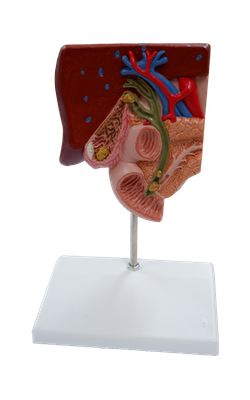Main Model

Gallstone in the fundus area of the gallbladder

A gallstone is a concretion in the gallbladder, cystic duct, or bile duct composed chiefly of cholesterol crystals. Gallstones (cholelithiasis) are much more common in females and their incidence increases with age. However, in approximately 50% of persons, gallstones are “silent” (asymptomatic). Over a 20-year period, two thirds of asymptomatic people with gallstones remain symptom free. The longer stones remain quiescent, the less likely symptoms are to develop. For gallstones to cause clinical symptoms, they must obtain a size sufficient to produce mechanical injury to the gallbladder or obstruction of the biliary tract.
The distal end of the hepatopancreatic ampulla is the narrowest part of the biliary passages and is the common site for impaction of gallstones. Gallstones may also lodge in the hepatic and cystic ducts. A stone lodged in the cystic duct causes biliary colic (intense, spasmodic pain). When the gallbladder relaxes, the stone may move back into the gallbladder. If the stone blocks the cystic duct, cholecystitis (inflammation of the gallbladder) occurs because of bile accumulation, causing enlargement of the gallbladder.
Another common site for impaction of gallstones is in an abnormal sacculation (Hartmann pouch), that appears in diseased states at the junction of the neck of the gallbladder and the cystic duct. When this pouch is large, the cystic duct arises from its upper left aspect, not from what appears to be the apex of the gallbladder. Gallstones commonly collect in the pouch. If a peptic duodenal ulcer ruptures, a false passage may form between the pouch and the superior part of the duodenum, allowing gallstones to enter the duodenum.
Pain from an impaction of the gallbladder develops in the epigastric region and later shifts to the right hypochondriac region at the junction of the 9th costal cartilage and the lateral border of the rectus sheath. Inflammation of the gallbladder may cause pain in the posterior thoracic wall, or right shoulder owing to irritation of the diaphragm. If bile cannot leave the gallbladder, it enters the blood and causes jaundice. Ultrasound and CT scans are common non-invasive techniques for locating stones.